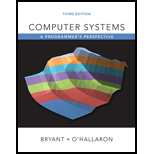
Computer Systems: A Programmer's Perspective (3rd Edition)
3rd Edition
ISBN: 9780134092669
Author: Bryant, Randal E. Bryant, David R. O'Hallaron, David R., Randal E.; O'Hallaron, Bryant/O'hallaron
Publisher: PEARSON
expand_more
expand_more
format_list_bulleted
Question
Chapter 9.9, Problem 9.7PP
Program Plan Intro
Dynamic allocator:
Dynamic allocator keeps the heap as a group of several size blocks; each block is an attached portion of virtual memory which is allocated or free.
- An allocated block has been clearly kept for use by the application.
- A free block is offered to be allocated.
Two types of allocators:
- 1. Explicit allocators
- 2. Implicit allocators
Explicit allocators:
Explicit allocators need the application to explicitly free any allocated blocks.
Implicit allocators:
Implicit allocators is the method of automatically releasing vacant allocated blocks. This is also known as garbage collection.
Implicit free list:
In this method, a block contains one word header, payload and additional padding. The header encrypts the block size, which contains header and padding; and check the block is allocated or free.
- If the arrangement is single-word, the block size is constantly a multiple of “4” and the low-order bits of the block size are always zero.
- If the arrangement is double word, the block size is constantly a multiple of “8” and the low-order bits of the block size are always zero.
- Thus, essential to store only the high-order “29 bits” of the block size, freeing the remaining “3 bits” to encrypt other information.
- Here, smallest significant bits is using to represent the block is allocated or free.
Expert Solution & Answer
Want to see the full answer?
Check out a sample textbook solution
Students have asked these similar questions
Solve in MATLAB
Hello please look at the attached picture. I need an detailed explanation of the architecture
Information Security Risk and Vulnerability Assessment
1- Which TCP/IP protocol is used to convert the IP address to the Mac address? Explain 2-What popular switch feature allows you to create communication boundaries between systems connected to the switch3- what types of vulnerability directly related to the programmer of the software?4- Who ensures the entity implements appropriate security controls to protect an asset?
Please do not use AI and add refrence
Chapter 9 Solutions
Computer Systems: A Programmer's Perspective (3rd Edition)
Ch. 9.2 - Prob. 9.1PPCh. 9.3 - Prob. 9.2PPCh. 9.6 - Prob. 9.3PPCh. 9.6 - Prob. 9.4PPCh. 9.8 - Practice Problem 9.5 (solution page 882) Write a C...Ch. 9.9 - Prob. 9.6PPCh. 9.9 - Prob. 9.7PPCh. 9.9 - Prob. 9.8PPCh. 9.9 - Prob. 9.9PPCh. 9.9 - Prob. 9.10PP
Ch. 9 - Prob. 9.11HWCh. 9 - Repeat Problem 9.11 for the following address....Ch. 9 - Repeat Problem 9.11 for the following address....Ch. 9 - Given an input file hello.txt that consists of the...Ch. 9 - Determine the block sizes and header values that...Ch. 9 - Prob. 9.16HWCh. 9 - Prob. 9.17HWCh. 9 - Prob. 9.18HWCh. 9 - Prob. 9.19HWCh. 9 - Write your own version of malloc and free, and...
Knowledge Booster
Similar questions
- Could you help me to know features of the following concepts: - commercial CA - memory integrity - WMI filterarrow_forwardBriefly describe the issues involved in using ATM technology in Local Area Networksarrow_forwardFor this question you will perform two levels of quicksort on an array containing these numbers: 59 41 61 73 43 57 50 13 96 88 42 77 27 95 32 89 In the first blank, enter the array contents after the top level partition. In the second blank, enter the array contents after one more partition of the left-hand subarray resulting from the first partition. In the third blank, enter the array contents after one more partition of the right-hand subarray resulting from the first partition. Print the numbers with a single space between them. Use the algorithm we covered in class, in which the first element of the subarray is the partition value. Question 1 options: Blank # 1 Blank # 2 Blank # 3arrow_forward
- 1. Transform the E-R diagram into a set of relations. Country_of Agent ID Agent H Holds Is_Reponsible_for Consignment Number $ Value May Contain Consignment Transports Container Destination Ф R Goes Off Container Number Size Vessel Voyage Registry Vessel ID Voyage_ID Tonnagearrow_forwardI want to solve 13.2 using matlab please helparrow_forwarda) Show a possible trace of the OSPF algorithm for computing the routing table in Router 2 forthis network.b) Show the messages used by RIP to compute routing tables.arrow_forward
- using r language to answer question 4 Question 4: Obtain a 95% standard normal bootstrap confidence interval, a 95% basic bootstrap confidence interval, and a percentile confidence interval for the ρb12 in Question 3.arrow_forwardusing r language to answer question 4. Question 4: Obtain a 95% standard normal bootstrap confidence interval, a 95% basic bootstrap confidence interval, and a percentile confidence interval for the ρb12 in Question 3.arrow_forwardusing r languagearrow_forward
arrow_back_ios
SEE MORE QUESTIONS
arrow_forward_ios
Recommended textbooks for you
 Systems ArchitectureComputer ScienceISBN:9781305080195Author:Stephen D. BurdPublisher:Cengage Learning
Systems ArchitectureComputer ScienceISBN:9781305080195Author:Stephen D. BurdPublisher:Cengage Learning C++ Programming: From Problem Analysis to Program...Computer ScienceISBN:9781337102087Author:D. S. MalikPublisher:Cengage Learning
C++ Programming: From Problem Analysis to Program...Computer ScienceISBN:9781337102087Author:D. S. MalikPublisher:Cengage Learning C++ for Engineers and ScientistsComputer ScienceISBN:9781133187844Author:Bronson, Gary J.Publisher:Course Technology Ptr
C++ for Engineers and ScientistsComputer ScienceISBN:9781133187844Author:Bronson, Gary J.Publisher:Course Technology Ptr New Perspectives on HTML5, CSS3, and JavaScriptComputer ScienceISBN:9781305503922Author:Patrick M. CareyPublisher:Cengage LearningProgramming Logic & Design ComprehensiveComputer ScienceISBN:9781337669405Author:FARRELLPublisher:Cengage
New Perspectives on HTML5, CSS3, and JavaScriptComputer ScienceISBN:9781305503922Author:Patrick M. CareyPublisher:Cengage LearningProgramming Logic & Design ComprehensiveComputer ScienceISBN:9781337669405Author:FARRELLPublisher:Cengage Microsoft Visual C#Computer ScienceISBN:9781337102100Author:Joyce, Farrell.Publisher:Cengage Learning,
Microsoft Visual C#Computer ScienceISBN:9781337102100Author:Joyce, Farrell.Publisher:Cengage Learning,

Systems Architecture
Computer Science
ISBN:9781305080195
Author:Stephen D. Burd
Publisher:Cengage Learning

C++ Programming: From Problem Analysis to Program...
Computer Science
ISBN:9781337102087
Author:D. S. Malik
Publisher:Cengage Learning

C++ for Engineers and Scientists
Computer Science
ISBN:9781133187844
Author:Bronson, Gary J.
Publisher:Course Technology Ptr

New Perspectives on HTML5, CSS3, and JavaScript
Computer Science
ISBN:9781305503922
Author:Patrick M. Carey
Publisher:Cengage Learning

Programming Logic & Design Comprehensive
Computer Science
ISBN:9781337669405
Author:FARRELL
Publisher:Cengage

Microsoft Visual C#
Computer Science
ISBN:9781337102100
Author:Joyce, Farrell.
Publisher:Cengage Learning,